Content
- 1 Fringed tulips general description.
- 2 Tulip cultivar Blue Heron (Blue Heron).
- 3 Tulip variety Davenport (Davenport).
- 4 Tulip cultivar Canasta (Canasta).
- 5 Tulip variety Fringed Elegance (Fringed Elegance).
- 6 Tulip variety Black Jewel.
- 7 Tulip cultivar Huis Ten Bosch.
- 8 Tulip variety Burgundy Lace (Burgundy Lace).
- 9 Mayan tulip cultivar (Maja).
- 10 Tulip variety Valery Gergiev.
Among the varietal tulips, fringed tulips are considered the most mysterious and, without exception, cause admiring attention. Their highlight is a fringe of various-sized, chaotically directed needle-shaped outgrowths, reminiscent of patterns made of frost crystals. The name of the fringed tulip variety Sundew translates as "sundew" - a plant-trap for insects. After all, another feature of fringed tulips is the ability of the flowers to close tightly, not allowing a bumblebee, for example, to look out at the nectar. We will talk in detail about other outlandish features and the variety of varieties of this group of tulips in the article.
Another difference between fringed tulips is thick, tough petals. They are much tougher and more durable than the petals of other classes of tulips, therefore they withstand rain and wind better and retain their original decorative effect throughout the entire flowering period.
The cultivation technique is the same as for other ornamental varieties, we wrote about it in the article on terry tulips.
Important! To preserve the original varietal degree of fringe, the dug out bulbs must be stored at a temperature of 24-29 ° C.
Popular varieties of fringed tulips
There are more than 50 varieties of fringed tulips. All of them are hybrids of different classes of tulips, therefore they differ greatly in height, shape and size of the flower. They bloom throughout May, some at the beginning of the month, others at the end.
The color of the flowers is very diverse, almost the entire color palette is present. There are only black fringed tulips, but there are more purple tulips than in other groups. There are varieties of one-color and two-color, with a border and fringe of a similar shade or contrasting color.
All fringed tulips are unusually beautiful: white with pink tints New Look, pink with a lighter border, fringe and bottom Fancy Frills, joyful and bright yellow Laverock, Hamilton, Warbler, Crispy Gold, strict and solemn dark - purple with dark red Cuban fringe Night, burgundy purple Gorilla.
The long snow-white fringe is practically indistinguishable from the frost crystals in the snow-white varieties: Daytona, Honeymoon, Swan Wings, Estafette. The same effect is obtained against the background of solid color petals in lilac Traveler, purple Regulus, American Eagle and Cummins, burgundy Randburg, bluish-lilac Canova.
The red varieties are very effective: Canasta - with white borders and fringes and Davenport - with yellow ones. The exquisite variety The Skiper is also mysterious, with petals shimmering in blue and purple, and a bronze border and fringe.
Recently, even more decorative varieties have been developed, with fringes covering the back of the flower like a beard. One of the varieties is called Barbados. Monochrome, dark red, with fringes up to 3 cm long over the entire surface of the petals outside, it really looks bearded. This variety is perhaps one of the most original and extravagant. Of the red favorites of gardeners, the Arma variety should be noted - the shortest of the fringed tulips. The petals are red, the fringe is scarlet. It has an early flowering period (early May) and a delicious aroma.
There are few fragrant varieties in the group of simple fringed tulips. In addition to Arma, red Miami Sunset, white-pink Pink Fountain, cream with red touches of Carrousel have a pleasant aroma.
Terry-fringed tulips
The flowers of this group are large, densely double, with needle-like fringes along the edges. They are so chic that it is impossible to take your eyes off.Every year the group is replenished with new varieties, more and more interesting and decorative.
Their stem is strong, about 40 cm high, large flowers - 10-15 cm in diameter, usually densely double, have 20 petals or more. There are varieties of an earlier flowering period (April-May), there are later ones (end of May). Some varieties have a delicate, sophisticated aroma.
Particularly striking is the pure white Snow Crystal variety, which not only has a large needle-like fringe, but the entire snow-white flower looks like a real winter sculpture.
The delicate pink Queensland and the hot pink Brest are amazingly beautiful, both with white edging and fringes. Cool Crystal petals include two shades of pink at once - very delicate, almost white, and bright.
Matchpoint has very bright flowers, each petal of which shimmers with pink, lilac, purple, Kingston has a rich raspberry color and Mascotte has rather dark, purple-blue flowers.
Mon Amour is considered the most spectacular yellow tulip - huge flowers, dazzling yellow color and very thick fringes. The yellow flowers of the Artichoke cultivar have casual orange streaks on the inner petals. Dutch Pioneer has orange flowers and yellow borders and fringes. An even brighter variety is Gold Dust with red flowers and thick yellow fringes.
Sensual Touch is one of the most popular varieties of terry-fringed tulips among gardeners. Its flowers combine two colors - orange and apricot, the border is thin, matte, the fringe is very neat. The flower is also neat, resembling a begonia or a rose in shape.
Cool Crystal has a very strong aroma, and Mon Amour and Gold Dust have a weaker but very pleasant aroma.
Fringed tulips in garden design
Tulips in garden design have already been written about in the article on terry tulips, so we will confine ourselves to a few additions.
● Fringed tulips are so decorative that their main place is in the foreground in flower beds and in mixborders in the most ceremonial places of your site; they will also look good against the background of stone walls or green hedges.
● It is better to plant them in places easily accessible to guests - almost no one is able to resist and not touch such beauty.
● You should not use fringed tulips in natural-style areas, for this they are too pretentious; however, there are exceptions - monochromatic varieties with a modest fringe, for example, the favorite variety of gardeners Arma, undersized and bright, will greatly decorate your alpine slide.
● Plants with bright, exotic flowers should not be taken as partners to them, fringed tulips look much better against the background of monochromatic green foliage or modest small flowers matched to the tone.
Be sure to plant fringed tulips in your area. Despite the exotic appearance of flowers in some varieties, these are all the same delicate spring flowers that give us joy, energy and a sense of a holiday in spring!
The unusual beauty of tulips from the garden class fringed lies in the fringe of their rigid needle-like outgrowths, which runs along the edges of the petals.

The first fringed variety, 'Sandju', was registered in Holland in 1930; its name, translated into Russian, meant "sundew" and was associated with this predatory plant, which holds prey with the cilia of its petals, by its external resemblance.
Currently, the assortment of fringed tulips has many varieties. This class of tulips is self-sufficient and diverse.
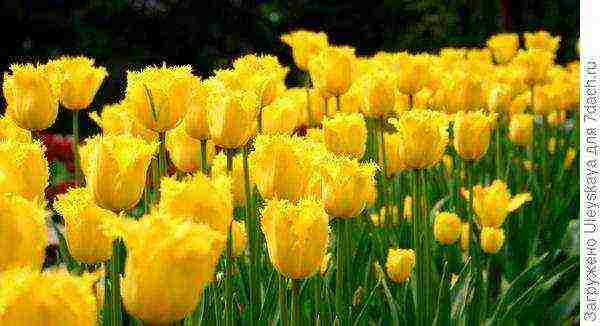
Fringed tulips vary in height. These are both babies on short peduncles, for example, ‘Cool Crystal’, and tall representatives with large goblet double flowers, resembling peonies, for example, ‘Exotic Sun’.
'Cool Crystal' variety 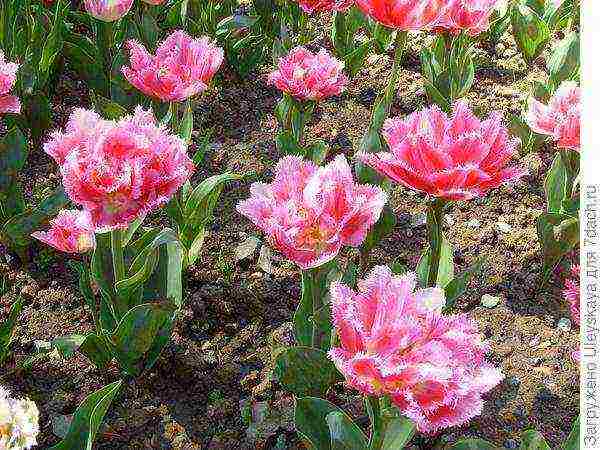
‘Exotic Sun’ variety 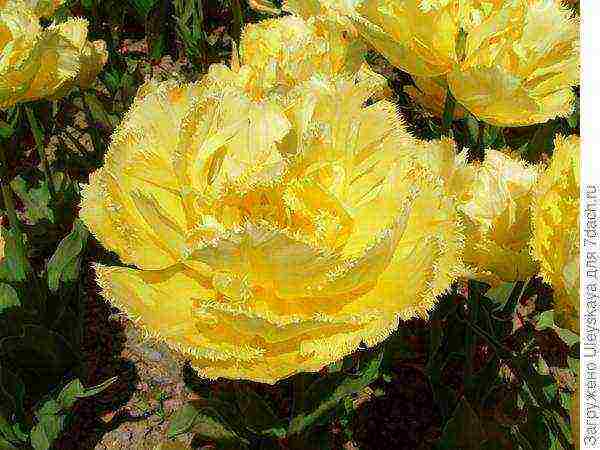
Fringed tulips have a huge color palette of colors: almost all colors and shades are found; sometimes the main background of a flower contrasts with a fringe of a different color.Refined monochromatic varieties such as 'Swan Wings' are pure white in color. The original two-tone varieties, such as 'Fancy Frills' pink and white or 'Esprit' yellow-orange, double.
Variety 'Swan Wings' 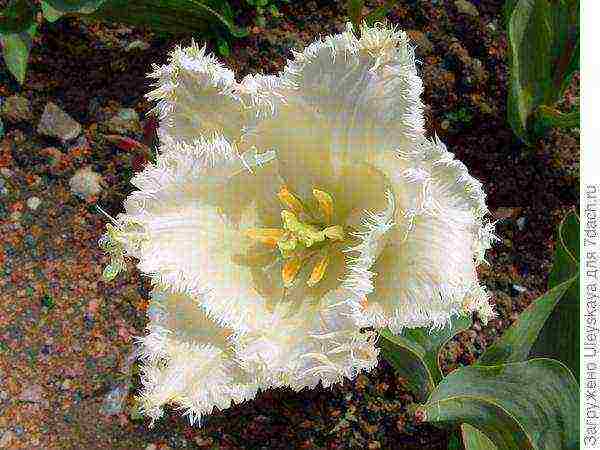
Variety 'Fancy Frills' 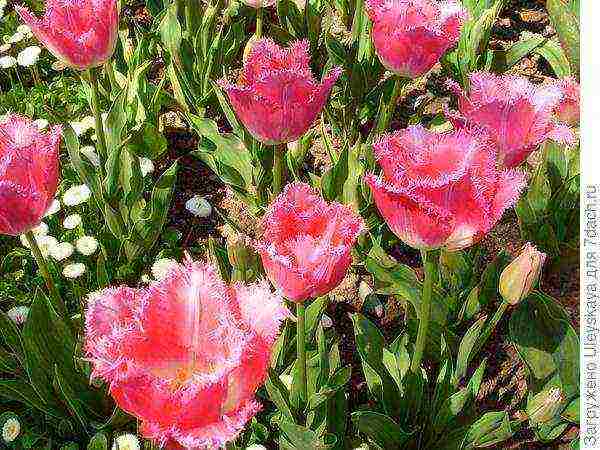
‘Esprit’ variety 
The class combines early, mid-flowering and very late varieties. Late flowering varieties such as 'Lambada', which have just begun to demonstrate their fiery Brazilian dance, are especially valuable.

Fringed tulips harmoniously fit into the mixborder's spring picture.
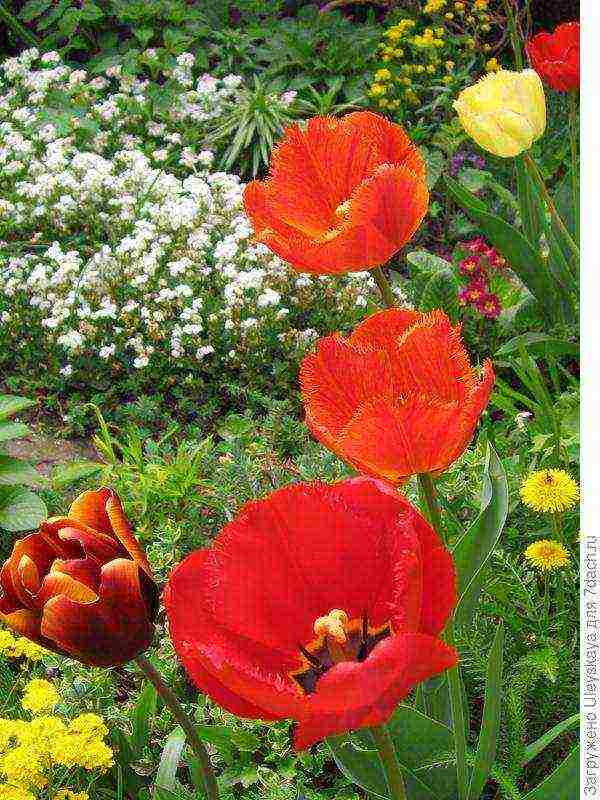
In the seventh grade, very rare varieties were combined with a beautiful fringe that adorns the petals and makes the flowers unusually decorative. Basically, the class included artificially bred varieties, which breeders from Holland, England and Sweden worked on.
A bit of history
The history of the seventh class tulips began in 1930. It was then that scientists first discovered a stunningly beautiful color mutation. Botanists have discovered an incredibly beautiful flower, which appeared as a result of a natural mutation of Darwin tulips and representatives of the Cottage group. The very first variety from this class, from which it all began, is Sundew.
Later, scientists set out to study the genetic characteristics of fringed tulips, and they managed to understand the mechanism of mutation. Using the baggage of the knowledge gained, they began to purposefully create new varieties by influencing the existing varieties of tulips, mutagenic factors. Thus, during the second half of the 20th century, the class was replenished with several dozen more varieties, with exceptional decorativeness. However, they did not become popular and widespread. Today these flowers are not of commercial interest, but they remain in demand among collectors and connoisseurs of beauty.
Fringed tulips general description.
To date, only a few varieties from this section are used for growing in large volumes. Typically used for forcing. But, the cultivation of such tulips requires a special approach, and often investment, because the varieties do not differ in endurance and adaptability.
Most often, fringed tulips are tall - up to 80 cm, sometimes slightly smaller. They have a unique characteristic - the edges of the petals are covered with a fringed, or needle-like border - each variety is different. This feature appeared as a result of the influence of a mutagenic factor, and thanks to it the decorativeness of the representatives of the seventh class of tulips is so highly valued.
Flowers can have different shapes - they are goblet and orchid (lily-colored - with a bent edge of the petal). But, fringed varieties differ in a denser texture of petals, and due to this, they are less sensitive to the effects of the external environment, they can withstand a cold snap, and retain decorativeness in cut for a long time. Stems are leafless or leafy, and root leaves collected in a socket are also necessarily present. As a rule, basal leaves have the same shape as stem leaves, but differ in length and larger sizes.
A significant drawback of mutated varieties with a beautiful fringe is sensitivity to the variegation virus, increased requirements for the composition of the soil, difficulties in care and significant problems with reproduction.
Flowering time
Fringed tulip varieties that are in the seventh class do not bloom earlier than mid to late May. The earliest representatives may start flowering towards mid-May, but most varieties still open their buds towards the end of this month.
Popular varieties
Mostly, fringed tulip varieties are grown for landscaping purposes and are used for winter forcing. Some of them are more popular, and are used more often, as growers liked their characteristics.Others, on the contrary, exist only in small quantities, and collectors and scientists are engaged in the issues of their preservation. So what are the varieties included in the seventh grade?
Tulip cultivar Blue Heron (Blue Heron).
Blue Heron tulip variety (see photo) - popular for forcing, but rarely grown for landscaping, as it has a significant drawback - under the influence of sunlight, its colors gradually fade. Blue Heron is a demanding variety, prone to disease, and therefore needs special conditions.
This is a flower, the height of which usually does not exceed 60 cm. The stems are strong, cylindrical and erect, while they are not leafy, but surrounded by a rosette of basal leaves. This variety is very beautiful during the flowering period. On the peduncle, single flowers open, the height of which is about 10 cm, and the diameter of the bowl is up to 6 cm. The flower has a lily-shaped shape, its delicate petals are bent outward. The edges of the petal are decorated with a border of small and thin needles-tassels. This flower is painted in a bluish-lilac shade, which turns into a light border at the edges of the petals.
Tulip variety Davenport (Davenport).
The Davenport tulip variety (see photo) is well suited for decorating flower beds and flower beds, gives a good distillation, due to its decorative effect and ability to maintain freshness for a long time, it is used in the design of beautiful bouquets and compositions. The tulip differs from most of its relatives from the seventh class in high growth, and can even stretch up to 80 cm. The flower has strong stems, powerful, pike-shaped, basal leaves expanding towards the center.
The flower is incredibly decorative. It consists of 6 petals, has a goblet shape, and its height is not less than 10 cm. Not only a border of small needles passing along the edges of all petals helps to emphasize decorativeness, but also an unusual, contrasting color. The base of the petal is deep red, and the border and the needle fringe are yellow. The fiery combination of shades during the flowering period will make any flower garden lively and bright.
Tulip cultivar Canasta (Canasta).
The Canasta tulip variety (see photo) is more hardy than the rest. In addition, it is very good at reproduction, it tolerates winter practically without problems in temperate climates and does not require annual digging of bulbs. A tall flower reaches about 70 cm, opens its buds closer to the end of May. Its flowers have a goblet shape, and the pointed petals are also decorated along the edges with a border of small needles.
The petal tissue is dense, but the border along the edges is more delicate and easily damaged. The advantage is resistance to sun and drafts. Beautiful petals are painted in a pinkish-red hue, and the border of needles is white. This versatile combination made the flower popular in landscaping, creating beautiful compositions. This variety looks especially good with green tulips.
Tulip variety Fringed Elegance (Fringed Elegance).
Tulip variety Fringed Elegance (see photo) is unique in its kind, as it has a unique shade. But, due to the tendency to disease and sensitivity to cold, it is used mainly for forcing, as well as for landscaping in southern regions, with a mild climate and low rainfall. Waterlogging is the most common cause of this variety. Fringed Elegance height - up to 70 cm.
The flowers are goblet, not too large - up to 9 cm in height. The border is also present - in the form of the smallest needles. The edges of the needles are emphasized by a thin, threadlike red line. The color of the needle border is beige and cream. The main shade in which the petals are painted is pale yellow, ivory. Open buds can be observed from about mid-May.
Tulip variety Black Jewel.
The Black Jewel tulip variety (see photo) is ideal for cutting. But, in landscaping, it can also be used quite successfully.Looks great in the design of compositions with white varieties, combined with pinkish and lilac varieties. Flowers grow on powerful peduncle stems. Flowering - solitary, observed in the second half of May and can last for 2 weeks.
The height of the stems is not more than 65 cm, and the flowers are about 9 cm.The leaves are only basal, powerful and wide, up to 45-50 cm long. opening a flower and under the influence of the sun fades a little.
Tulip variety Huis Ten Bosch (Huis Ten Bosch).
Tulip Hughes Ten Bosch (see photo) differs from other representatives of its group in that its flowers are slightly smaller. Today, this variety is the least common due to problematic breeding and the need to dig up the bulbs every year. Hughes Ten Bosch is not the tallest variety, its height is about 60 cm. Its flowers can be maximum 7-8 cm, and they have a goblet, classic shape.
Tulip petals have a truly exotic color. At the base, they are greenish-white, and closer to the edges, the shade smoothly passes to a rich, pinkish. The border of the petals is needle-like. So that during the flowering process the tulip does not lose its decorative effect, it cannot be planted in open, well-lit areas. Hughes Ten Bosch blooms for a relatively short time - up to 10-12 days.
Tulip variety Burgundy Lace.
The Burgundy Lays tulip variety (see photo) is highly valued for its brightness and richness of colors. The color of the flowers is pinkish-crimson, intense and not subject to fading. Thanks to such a brightness of colors, the variety can be combined with almost all contrasting varieties of tulips. Due to its short stature - about 55 cm, the flower is good for planting in the foreground in the design of flower beds and flower beds.
Its buds are able to open in the second half of May. The goblet flowers are bordered by a needle-like fringe, maximum 7 cm in height, and not more than 5 cm in diameter. A feature of the variety is its very high potential for reproduction.
Mayan tulip cultivar (Maja).
The Mayan tulip variety (see photo) is one of the latest in the group under consideration. It blooms closer to the end of May, but at the same time retains its beauty and decorative effect for a long time. The flowering phase can last about 16-18 days. Tulip stems are strong, tall - up to 80 cm. Large, goblet flowers open on these powerful stems - up to 12 cm. The petals are monochromatic, bright, rich yellow. Initially, when the bud opens, orange notes are present, but later the petals fade to a bright yellow, sunny hue. Needle border in the same shade as the petals.
Tulip variety Valery Gergiev.
Tulip Valery Gergiev (see photo) is a masterpiece that was created by one of the most famous breeders. Despite the fact that this flower is one of the smallest and smallest in the class under consideration, it never goes unnoticed in the overall floral arrangement due to its beautiful color and unique, needle-like, long fringe.
The height of the plant is a maximum of 50 cm. The flowers are small, goblet, about 6-7 cm, painted in a rich, blood-red hue. Variety Valery Gergiev loves the sun, needs complex feeding, and also requires shelter for the winter in a harsh climate.
Simple, fringed, lily-colored, parrot and, of course, terry tulips - it is impossible to imagine a spring garden without these popular primroses. Each variety has its own zest and only its inherent charm, but terry varieties are perhaps the brightest and most festive. About them, refined and unique - the topic of today's conversation.
 The first impression of densely doubled tulips is that they are poppies or peonies. How did the tulips look like peonies?
The first impression of densely doubled tulips is that they are poppies or peonies. How did the tulips look like peonies?
More than five and a half thousand varieties of tulips are officially registered in the world. The terry variety is not the most common, about 9% of the world's assortment, but has been known for a long time.
The first hybridization, which turned a part of the perianth into an additional circle of petals, occurred in nature; growers only selected the most interesting specimens obtained from random cross-pollination. So, by 1620 in Holland, the first varietal group of tulips, Duke van Toll, was formed, represented by low squat plants not exceeding 15–20 cm - it is from this group that the early double species most likely originated.
Late double tulips appeared a little later - in the second half of the 17th century. Exotic varieties were few, they were valued, but with the development of artificial crossing, which appeared 100 years later, they "disappeared in time."
One of the later alleged ancestors is the snow-white terry variety Murillo, which has been cultivated for more than 200 years.
Since the 19th century. doubleness of tulips develops as a result of hybridization and genetic mutation.
 Navy, freedom and tulips - 3 main objects of pride for the Dutch in the middle of the 17th century
Navy, freedom and tulips - 3 main objects of pride for the Dutch in the middle of the 17th century
Double-flowered tulips are often called peony tulips. There really is a similarity. Especially at the peak of flowering, when squat plants lean to the ground under the weight of lush, as if stuffed with petals, heads.
Two classes of peony tulips are officially distinguished:
- early, blooming together with common relatives;
- late blooming, blooming two weeks later.
The early group is strong bushy plants that drive out a stem that rarely exceeds 25-30 cm, and in some varieties it barely reaches 10-15 cm. A medium-sized flower, up to 8 cm in diameter with a warm color - yellow, pink, red, orange, white. In landscape design, they are often used as border spring flowers, beautifully framing paths, lawns, flower beds. A terry tulip is also good in a pot culture.
Late group - densely double beauties on strong, slender peduncles 40-60 cm long. The flower has 3-4 or more rows of petals, large size, monochromatic and two-color, and the colors vary from snow-white to almost black. Plants are suitable for decorating parks and squares, they look amazing when cut.
One cannot ignore one more group of late tulips - fringed ones. Breeders based on them have brought out many multi-layered varieties, each petal of which is additionally framed with "cilia" - a double beauty has turned out. An example of fringed + double tulips - varieties Brest, Mascott, Vaya Kon Dios, etc.
 In the photo - undersized terry primroses form a beautiful border
In the photo - undersized terry primroses form a beautiful border
Having shoveled more than one catalog, having studied the reviews of flower growers, we settled on varieties that can become a worthy decoration for any garden.
Top 5 early varieties
There are a great many beautiful early tulips with double flowers. The list includes specimens with additional characteristics such as amicability and duration of flowering, resistance to changeable spring weather and diseases, and stem strength. The latter quality is especially important for varieties with large, heavy heads.
- Abba is a Dutch undersized dense double variety. The flower is a magnificent scarlet glass 6 cm high and up to 10 cm in diameter. The outer row of petals is decorated with dark green backs. Cold-hardy, blooms in April and pleases with amicable flowering for 3 weeks.
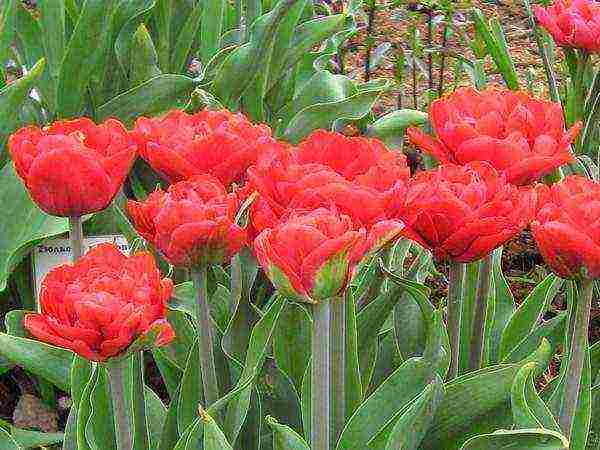 Abba colors the flowerbed with flaming glasses
Abba colors the flowerbed with flaming glasses - Zizania is one of the earliest tulips, blooming in March – April. It has an unusual color - dark pink petals are edged with a creamy white stripe. For early varieties, it is quite high (stem up to 45 cm), which is important for those who are engaged in forcing culture.
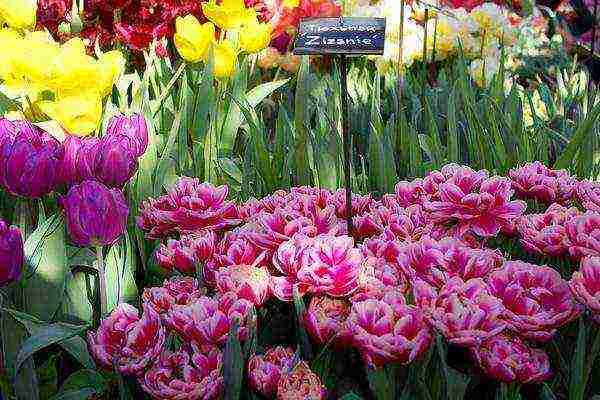 Zizania variety
Zizania variety - Monte Carlo is a very spectacular variety with sunny yellow flowers that seem to have absorbed all the gold of the famous namesake city. The plant is low (up to 30 cm), blooms in April, retains decorative effect for two weeks.
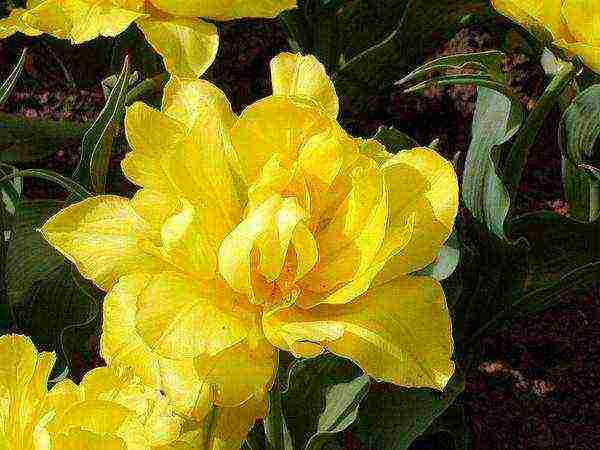 Lush Monte Carlo buds with delicate green strokes on the backs of the petals
Lush Monte Carlo buds with delicate green strokes on the backs of the petals - Double Toronto is an unusual flower obtained by hybridizing double varieties with Greig's tulip. The plant is bushy, multi-flowered, the petals are narrow, pointed, saturated purple with a terracotta tint.
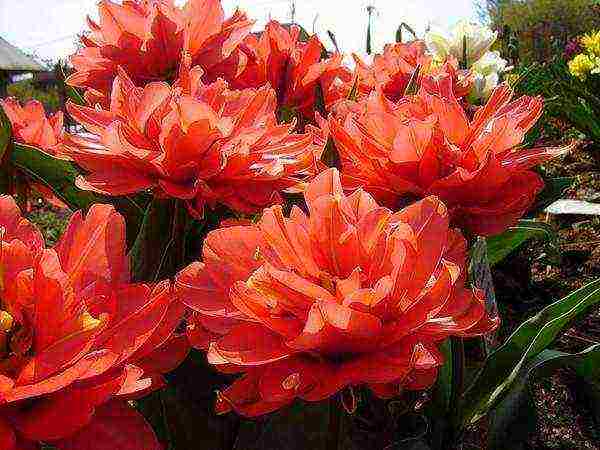 The vibrant colors of the Double Toronto hybrid
The vibrant colors of the Double Toronto hybrid - The orange princess is a tulip, time-tested and the love of flower growers. The bright orange flowers with red strokes, similar to rosebuds, were first presented at the exhibition in 1983 and still have not lost their relevance. The plant has a strong 40-centimeter stem, long flowering, resistance to viral mutations.
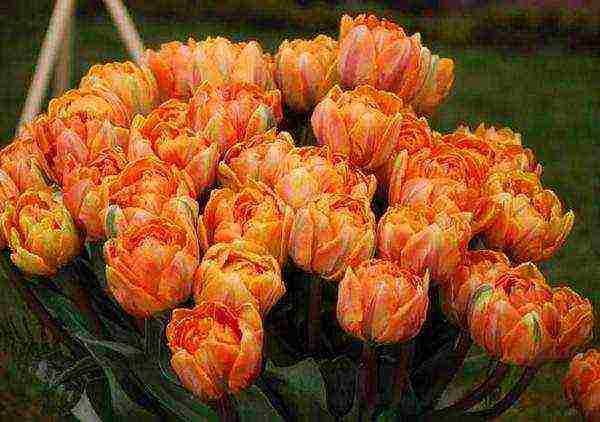 Orange Prince is one of the large-flowered representatives of the terry family
Orange Prince is one of the large-flowered representatives of the terry family
Among the early tulips, other terry varieties stand out for their high decorativeness:
- Royal Acres (purple);
- Totem (boiling white with green stripes on the back of the petals);
- Royalty (red with a lighter edging and a green stripe in the center of the petal);
- Red Princes (bright red with pearlescent tints).
The "Magnificent Five" of late-blooming peony tulips
Even more numerous is the late flowering family of the group of primroses of interest to us. It is impossible to single out the best ones. The proposed five were selected so that diverse varieties in flower shape, color, not only fashionable, but firmly occupied their niche in the market of bulbous plants were presented.
- Angelica is one of the old varieties that have not lost their relevance. Delicate pink with white stains, the flower smells amazing. As it blooms, coral tones emerge inside the bowl, making the tulip brighter. This variety also has a modern orange variety.
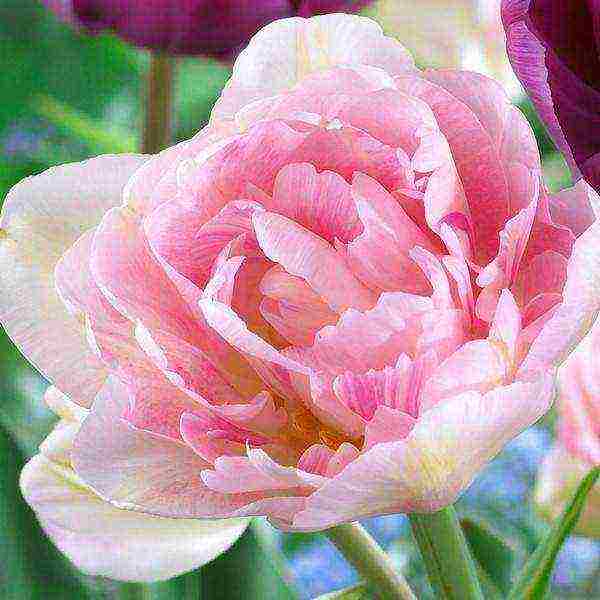 In the photo - tulip Angelica
In the photo - tulip Angelica - Miranda is another old-timer who fell in love with its lush purple flower on a strong, slender peduncle, resistance to disease and the ups and downs of the weather. The densely doubled, almost monochromatic bowl has over 50 petals that last up to 3 weeks.
 Miranda is one of the most attractive and viable representatives of the peony group.
Miranda is one of the most attractive and viable representatives of the peony group. - San Laver - with all its appearance confirms the love for the sun, inherent in the name. The flower of the regular peony-shaped form unfolds in its splendor gradually - from orange-red buds to a multi-tiered combination of orange petals with scarlet and yellow veins. The buds open slowly, reaching 12 cm in diameter at the peak of flowering.
 San Laver is one of those varieties that change color during flowering
San Laver is one of those varieties that change color during flowering - Blue Diamond is a beautiful large-flowered purple-violet variety with a high degree of doubleness. The petals are wide, doubled, and due to the darker veins, they seem to be corrugated. The peduncle is low (25–40 cm), but strong, the plant is resistant to winds and lodging. It blooms from mid-May, it can also capture June.
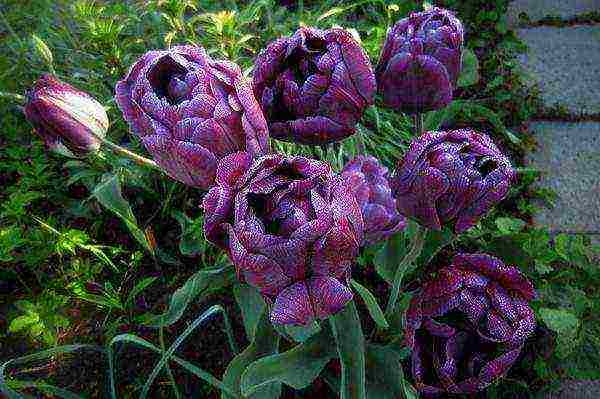 In the photo - Blue Diamond, blue tulip
In the photo - Blue Diamond, blue tulip - Double Touch are large double-colored balls, the delicate cream petals of which are framed with a crimson border. Expels a long (up to 50 cm) strong peduncle. The half-open bud is rather creamy, the bright edging is only indicated, during the flowering the glass gradually gains a pink color. They look amazing and stand in the cut for a long time.
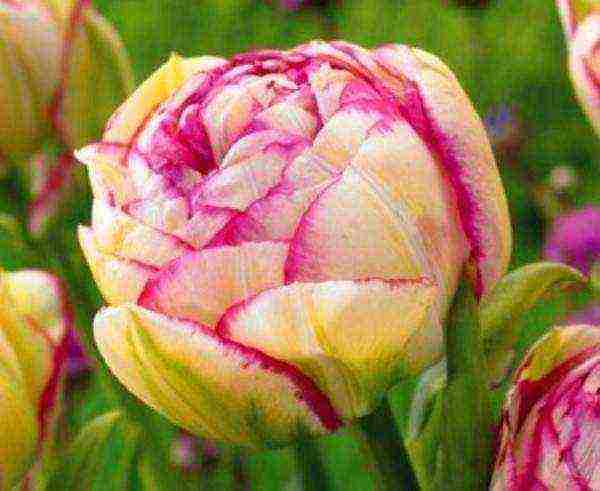 Double Tachch variety - why not peonies!
Double Tachch variety - why not peonies!
When replenishing the collection of tulips with double varieties, consider the color of the flower:
- Drumline, Virosa (wine red with cream border);
- Yellow Pompom (orange-yellow);
- White Touch (snow white);
- Sinopel (green);
- Rosario Double (pink, characteristic peony-shaped).
Fringed multilayer tulips
You cannot ignore the amazing terry beauties crossed with a fringed group. The needle edge adds splendor and decorativeness to the flower, they look very unusual both in the flower bed and in the cut.
- Snow Crystal - snow-white balls with a needle-like fringe. A high leg (up to 80 cm) and a flower with a diameter of more than 12 cm make them indispensable for cutting.
- Brest is a fringed multilayer variety. The red petals with light edging are adorned with white fringes.
- Artichoke - an exotic hybrid will appeal to lovers of trendy green-colored tulips. The petals, greenish with pink highlights, really resemble artichoke scales.
- Mascott is a pink double fringed tulip. The glass is small, 5–7 cm in diameter, but densely packed with petals, on a low (up to 40 cm) thick stem.
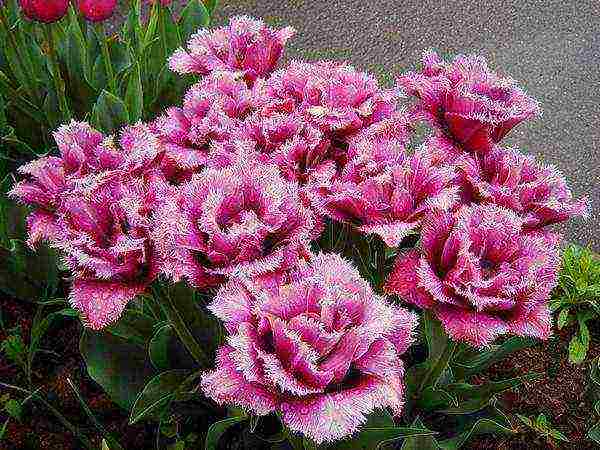 Tulip Mascott - it looks like the flowers are covered with hoarfrost
Tulip Mascott - it looks like the flowers are covered with hoarfrost
Other unusual terry varieties
Among the two-colored tulips of the terry group, it is worth highlighting the Ice Cream series (we also call it Plombir or Ice Cream). Behind the outer edge of the crimson petals is a pale white "dessert" that appears as the bud opens. The photo below shows how charming and original the flower is.
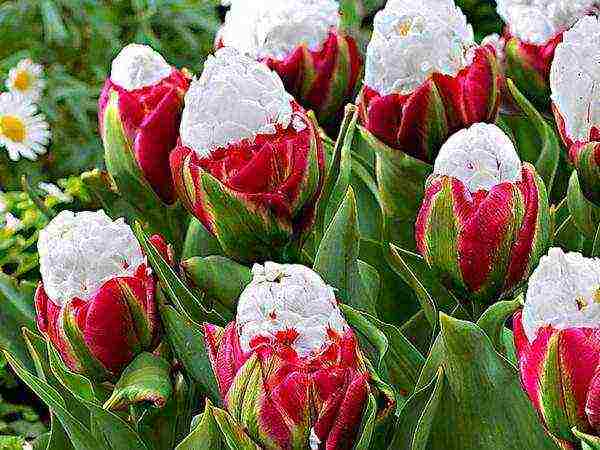 Glasses of ice cream - Ice Cream variety series
Glasses of ice cream - Ice Cream variety series
The technology for growing tulips of ordinary and terry tulips is almost identical, but there are several nuances that are worth paying attention to.
- If simple tulips for 2-3 years can do without digging, this approach is unacceptable for terry tulips. They need to be transplanted annually and preferably to a new place in order to protect sissies from diseases. How not to remember here planting bulbs in containers - the method will greatly facilitate the task and help not to confuse varieties.
- After cutting the flower, make sure that leaves remain on the bush. This is the key to the formation of a large healthy bulb next season.
- Be sure to decapitate (break off the head) of faded plants. The goal is still the same - high-quality planting material.
- Remove weakened, discolored specimens immediately, without waiting for a general dig. This will save the rest of the plants from possible infection.
- To unleash the full potential of peony tulips, plant them in well-lit, sunny areas.
- Feed the flowers at least 3 times per season - in early spring (fertilizers with a predominance of nitrogen), during the budding period (potassium and phosphorus are important), after flowering (complex fertilizers).
And most importantly, show care and love for your green pets. They will appreciate it. And they will color the spring garden with all the colors of the rainbow.
Video about the flowering of terry tulips
Moscow, Russia, on the site since 11.01.2017


